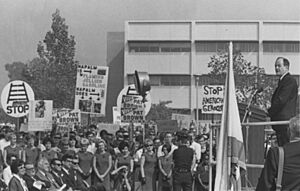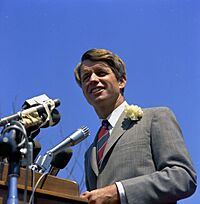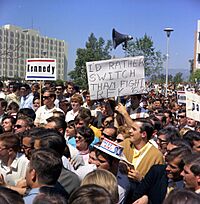California State University, Northridge facts for kids
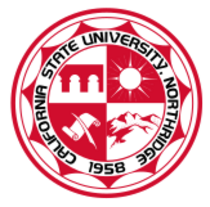 |
|
|
Former names
|
Satellite campus of Los Angeles State College (1952–1958) San Fernando Valley State College (1958–1972) |
|---|---|
| Motto | Vox Veritas Vita (Latin) |
|
Motto in English
|
"Speak the truth as a way of life" |
| Type | Public university |
| Established | 1958 |
|
Parent institution
|
California State University |
| Accreditation | WSCUC |
|
Academic affiliations
|
CUMU |
| Endowment | $229.4 million (2024) |
| Budget | $574.9 million (2024) |
| President | Erika D. Beck |
| Provost | Meera Komarraju |
|
Academic staff
|
2,173 (Fall 2024) |
|
Administrative staff
|
1,907 (Fall 2024) |
| Students | 36,848 (Fall 2024) |
| Undergraduates | 32,499 (Fall 2024) |
| Postgraduates | 4,349 (Fall 2024) |
| Location |
,
California
,
United States
34°14′30″N 118°31′42″W / 34.24167°N 118.52833°W |
| Campus | Large city, 356 acres (144 ha) |
| Newspaper | Daily Sundial |
| Colors | Red and black |
| Nickname | Matadors |
|
Sporting affiliations
|
|
| Mascot | Matty the Matador |
 |
|
California State University, Northridge (also known as CSUN or Cal State Northridge) is a public university in the Northridge area of Los Angeles, California. It is part of the larger California State University system. With over 36,000 students, it has one of the largest student populations in the system.
The university helps the California economy by generating about $1.9 billion each year. CSUN has over 2,000 faculty members who teach and do research.
CSUN started as a small branch of another college. It became its own independent college in 1958, called San Fernando Valley State College. In 1972, it got its current name. A major event in its history was the 1994 Northridge earthquake, which caused $400 million in damage to the campus.
The university offers 134 different degree programs for students. It is also home to the National Center on Deafness. CSUN is known for being a Hispanic-serving institution, which means it has a large number of Hispanic students.
Contents
History of the University
How CSUN Got Started
The idea for CSUN began in 1952. At first, a new college campus was planned for a different part of Los Angeles. But leaders from the San Fernando Valley convinced state officials to build it in Northridge instead.
Classes first started in 1955 at a local high school. The official groundbreaking for the new campus happened on January 4, 1956. At the time, the area was mostly farmland.
Becoming an Independent College (1956–1965)
The new campus opened with temporary buildings in 1956, with 1,500 students. On July 1, 1958, the campus officially separated from Los Angeles State College. It was renamed San Fernando Valley State College.
The first president was Ralph Prator. Enrollment grew to over 2,500 students. In 1959, the college was the first in the state to have its own computer. By 1964, almost 12,000 students were enrolled. Many new buildings were constructed during this time. The college also started its own radio station, KCSN, in 1963.
Important political figures visited the campus. In 1960, Lyndon B. Johnson, who was running for vice president, held a rally. Four years later, Republican candidate Nelson Rockefeller also spoke to students on campus.
A Time of Change (1966–1972)
Like many colleges in the 1960s, the campus saw many student protests. Students demonstrated against the Vietnam War. When Vice President Hubert Humphrey visited in 1966, he was met by student protesters. In 1968, Robert F. Kennedy gave a speech on campus against the war to a crowd of 10,000 people.
The year 1968 was a time of great change across the country. After the assassination of Martin Luther King Jr., students on campus pushed for more diversity. A group of African American students met with the college president to demand more minority students and teachers. Their actions led to the creation of new departments for Africana and Chicano/a studies.
The campus also hosted famous musicians. Janis Joplin performed in 1968. In 1969, the Newport Pop Festival was held on campus land. It featured famous artists like Jimi Hendrix and Ike & Tina Turner.
On June 1, 1972, the college was officially renamed California State University, Northridge.
Growth and Expansion (1973–1988)
The university's main library, now called the University Library, opened in 1973. By 1977, enrollment had grown to over 28,000 students. In 1981, the university started a foreign exchange program with countries like Japan, China, and Brazil.
In 1974, CSUN opened a smaller campus in Ventura, California. This campus later became its own university, California State University, Channel Islands.
The Northridge Earthquake and Rebuilding (1989–1997)
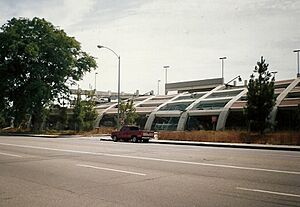
On January 17, 1994, a powerful earthquake struck very close to the campus. It caused $400 million in damage, the most ever for an American college campus. Many buildings, including parts of the library, were too damaged to use. A large parking garage completely collapsed.
Even with the damage, classes started just two weeks later. Students attended class in tents, temporary buildings, and at nearby colleges while the campus was rebuilt. President Bill Clinton visited the campus one year after the earthquake to mark the anniversary.
A Modern University (1997–2019)
The university finished its earthquake recovery program in 2003 with the opening of two new buildings, University Hall and Manzanita Hall. In 2007, CSUN built a large fuel cell power plant, the biggest of its kind at any university in the world.
During the 2008 financial crisis, students protested against budget cuts and higher tuition fees. These protests showed that the campus continued its long history of student activism.
During this time, the university received large donations. These gifts helped fund new programs and buildings. Major donations included $10 million from music producer Mike Curb and $10 million from businessman David Nazarian.
Recent Years (2020–Present)
Like other universities, CSUN was affected by the COVID-19 pandemic. In March 2020, all classes moved online. The campus later became a vaccination site, where about 250,000 people received their shots.
In 2021, CSUN received two of the largest donations in its history. The first was a $40 million gift from author MacKenzie Scott. The second was a $25 million donation from Apple. This money was used to create a center to help students from diverse backgrounds succeed in science, technology, engineering, and math (STEM) careers.
Campus Life and Buildings
Interesting Places on Campus
The CSUN Botanic Garden is a beautiful garden on campus. It is used for teaching biology students and is open to the public. The campus also has one of the last historic orange groves from the 1920s, a reminder of when the San Fernando Valley was covered in citrus farms.
University Library
The University Library is a huge building with over 1.3 million books and access to thousands of online journals. It uses a special robotic system to store and retrieve books, which can hold up to 1.7 million items.
The library was once named after Delmar Oviatt, an early leader of the college. In 2020, the name was changed to University Library.
Younes and Soraya Nazarian Center for the Performing Arts
This building, also known as The Soraya, is a major performance hall that opened in 2011. It cost $125 million to build. It has a large concert hall that can seat 1,700 people and a smaller theater. In 2017, it was renamed after Younes Nazarian and his wife Soraya, who donated $17 million.
Student Union and Wellness Centers
The University Student Union (USU) is a center for student life. It offers programs, services, and places for students to relax. The Oasis Wellness Center is part of the USU and offers students a quiet place with massage therapy, yoga, and sleep pods.
The Veteran Resource Center helps military veterans who are now students. The CSUN Food Pantry provides free food and personal items to students and community members in need.
National Center on Deafness
Established in 1972, this center provides support for deaf and hard-of-hearing students. It offers services like sign language interpreters and notetakers. The center makes CSUN a leading university for deaf education.
Sports and Athletics
CSUN's sports teams are called the Matadors. The school competes in 19 different sports at the NCAA Division I level, which is the highest level of college sports. Teams include basketball, soccer, baseball, softball, and volleyball.
Before moving to Division I in 1990, CSUN won 34 national championships at the Division II level. The school's mascot, the Matador, was chosen by students in 1958. The school colors are red and black.
The men's and women's basketball and volleyball teams play in the Matadome, an arena on campus.
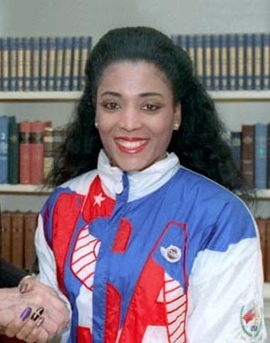
Student Life
Clubs and Events
CSUN has over 300 student clubs and organizations, including many fraternities and sororities. The university has strict rules against hazing to keep all students safe.
The university hosts many events for students. Big Show is a yearly concert on the Oviatt Library lawn. Students vote for the musicians they want to see perform. Past performers include Diplo, Big Sean, and Louis the Child.
Big Lecture is a speaker series that brings famous people to campus to share their stories. Past speakers have included actor James Franco, basketball legend Magic Johnson, and actress Viola Davis.
Famous People from CSUN
CSUN has over 350,000 alumni. Many have become famous in politics, business, entertainment, and sports.
- Doug Emhoff, the first Second Gentleman of the United States, is a CSUN graduate. He is married to Vice President Kamala Harris.
- Eva Longoria, an award-winning actress known for the TV show Desperate Housewives.
- Richard Dreyfuss, an Academy Award-winning actor.
- Paula Abdul, a Grammy and Emmy-winning singer and choreographer.
- Florence Griffith Joyner, an Olympic track and field star who won five medals and is considered the fastest woman of all time.
- Mike Curb, a former Lieutenant Governor of California and a successful music producer.
- Gene Haas, founder of Haas Automation, a major machine tool company, and the Haas F1 Team in Formula One racing.
- Scott J. Horowitz, a former NASA astronaut who flew on four Space Shuttle missions.
-
Eva Longoria, award-winning actress
-
Scott J. Horowitz, NASA astronaut
-
Mike Curb, 42nd Lieutenant Governor of California and musician
-
Stan Polovets, former CEO of the Alfa Group Consortium and current CEO of the Genesis Prize Foundation
-
Richard Dreyfuss, Academy Award–winning actor
-
Paula Abdul, Emmy and Grammy Award-winning singer and choreographer


